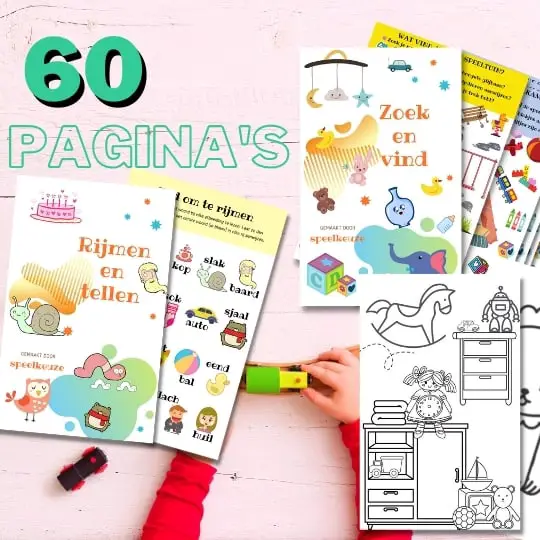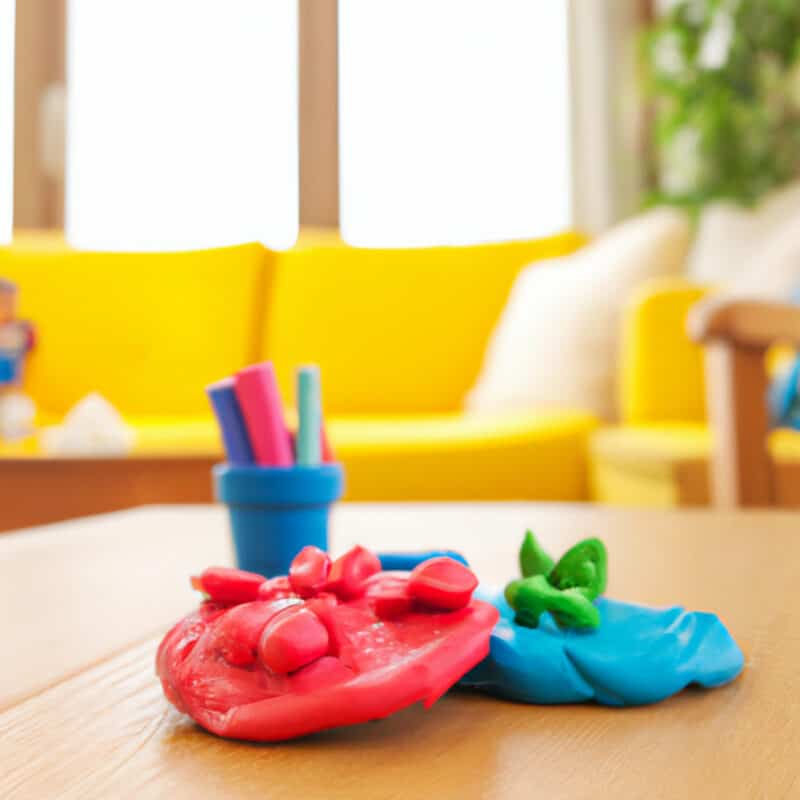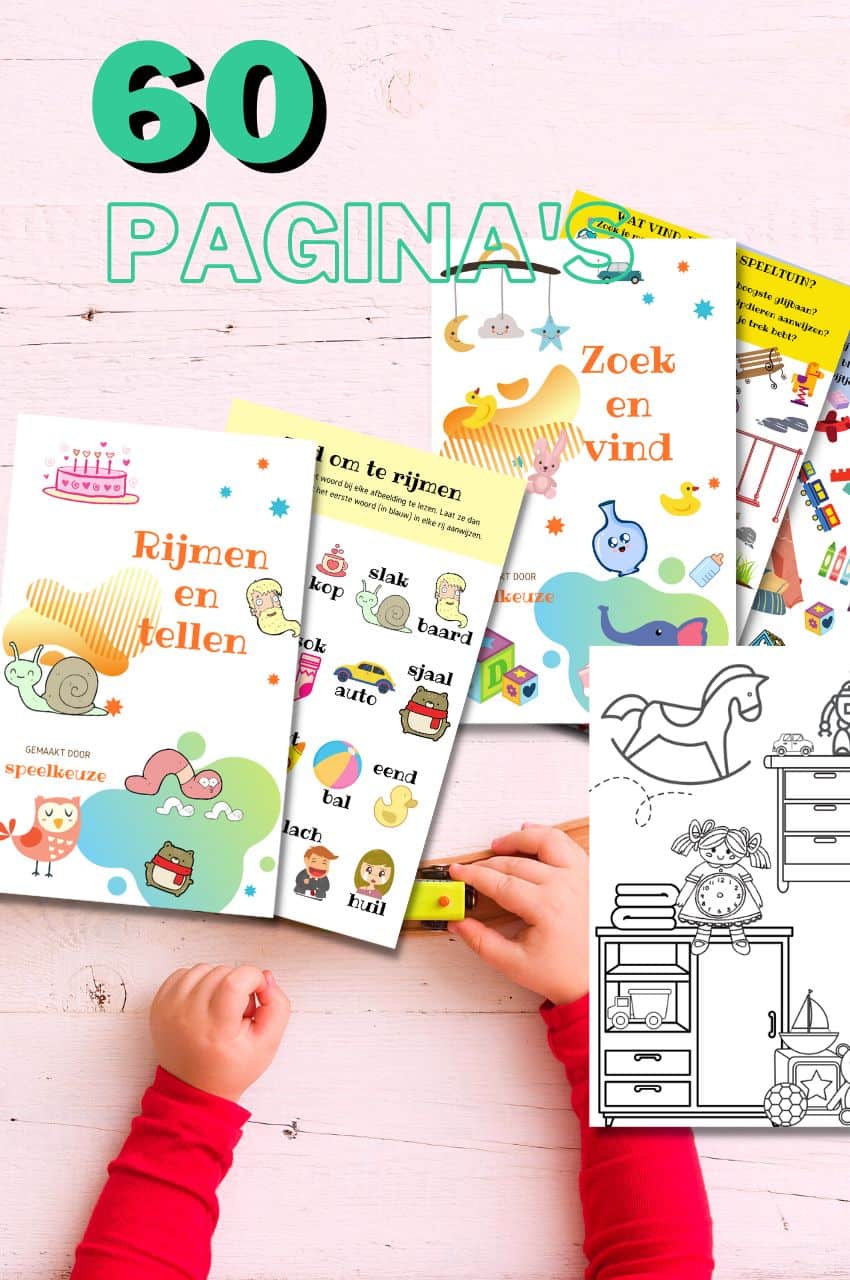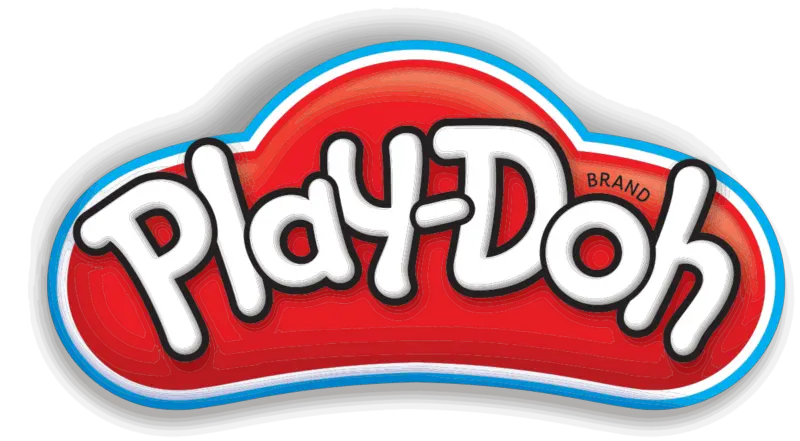Play-Doh: Discover The Colorful World Of Play Clay

Always something to do for the holidays or rainy day?
Play Choice now has the ultimate activity book collection, with over 60 pages of fun coloring pages and educational puzzles.
What is Play-Doh and what can you do with it?
Play-Doh is a clay-like toy made from water, salt, flour and dyes that allows children to let their imagination run wild.
It was first made in Japan in 1956 and was designed for children to play with.
In this article I will tell you all about the history, properties and possibilities of this popular and safe toy brand.


From toddler to toddler activity book collection
Educational games and coloring pages for 3 to 6 years
Your toddler and preschooler will love this e-book, along with the accompanying printables. He or she can play with it at every stage of development, together with mom and dad.
Buy at Bol.comWhat we discuss in this comprehensive post:
- 1 Play-Doh: The ideal age to start modeling
- 2 What's in Play-Doh compound?
- 3 A brief history of Play-Doh
- 4 The Wonderful World of Play-Doh: Explore the Possibilities!
- 5 Modeling with Play-Doh: a fun pastime for kids
- 6 Can Play-Doh go in the oven?
- 7 Play-Doh vs Kinetic Sand
- 8 Play-Doh vs Slime: Comparing Goodies
- 9 Play-Doh vs Modeling Clay: What Are the Differences?
- 10 The difference between Play-Doh, Fimo clay and DAS clay
- 11 Is Play-Doh Safe?
- 12 FAQ
- 12.1 What can you make with Play-Doh?
- 12.2 What age is Play-Doh for?
- 12.3 White dots on Play-Doh?
- 12.4 Can Play-Doh clay go in the oven?
- 12.5 What's the best way to store Play-Doh?
- 12.6 Can I mix Play-Doh to make new colors?
- 12.7 What should I do if Play-Doh gets on the floor or in clothes?
- 12.8 Is Play-Doh suitable for children with allergies?
- 13 Conclusion
Play-Doh: The ideal age to start modeling
Play-Doh is a popular clay brand that has been around for years creativity stimulates children. It is suitable for children from 3 years old.
But did you know that there are also play clays on the market today that are specially adapted for even younger children?
For example, there are the My First sets from SES Creative, which are suitable for children from about 1 year old.
If you are going to buy clay, pay close attention to the age indication on the packaging.
Why is Play-Doh so popular?
Play-Doh has been around since the 50s and was originally developed by an Ohio toy manufacturer.
The product was initially used as educational material in schools, but soon the makers saw the potential for home use.

They started selling Play-Doh in department stores and promoted it as a fun and... creative toys for children.
Since then, the brand has grown into a global phenomenon with countless sets, figures and accessories, such as the Play-Doh Fun Factory and the Play-Doh Cupcake Factory.
What makes Play-Doh great for young children?
Play-Doh is great toys for children 4 years old and also older.
Play-Doh is primarily made from a mixture of flour, water, salt, and food coloring, making it safe for children to play with.
In addition, the clay is soft and easy to knead, making it perfect for small hands.
Playing with Play-Doh helps children develop their fine motor skills to develop and stimulate them creativity.
Where can you buy Play-Doh?
Nowadays you can find Play-Doh in almost all toy stores and department stores, but also online at various webshops.
When buying Play-Doh, always pay attention to the age designation and choose a product that is suitable for your child.
What's in Play-Doh compound?
Have you ever wondered what's in Play-Doh compound? Well, the secret has finally been revealed!
Play-Doh clay is composed of wheat flour, sodium chloride, calcium chloride, potassium hydrophosphate, aluminum sulfate, water and oil.
Play-Doh is safe
Don't worry if your little one accidentally takes a bite of Play-Doh - it's not dangerous.
Children on a gluten-free diet should be careful, because it contains wheat flour.
Play-Doh is from Hasbro
Play-Doh is a Hasbro product, so you can be sure it's of high quality.
So if you're looking for a fun, safe way to get your kids to knead, squeeze, and knead, Play-Doh is the perfect choice.
A brief history of Play-Doh
Play-Doh has been loved since 1930 toys for children.
What once started as a cleaning agent for wallpaper, was eventually adapted so that children could model with it.
In 1956, Play-Doh was first demonstrated at an education convention and department stores saw the potential.
Since then it has been a popular product and almost everyone has played with Play-Doh as a child.
The Wonderful World of Play-Doh: Explore the Possibilities!
Play-Doh comes in a wide variety of colors, allowing your child to unleash their creativity.
From bright colors to soft pastels, there's always a color to match your child's creative ideas.
Stimulate development and skills with Play-Doh
Playing with Play-Doh is not only fun, but also good for your child's development. It stimulates fine motor skills, creativity and problem solving.
In addition, children learn to recognize shapes and colors and they can use their imagination to make the nicest creations.
Types of toys and accessories for Play-Doh
Today, there is a wide variety of Play-Doh toys and accessories on the market. For example, think of:
- Molds to make animals or other figures
- Sets to recreate pizzas and ice creams
- Tools for cutting, rolling and shaping the clay
- Play sets with themes, such as hairdressers, bakers or vets
So there is something fun for every child to play with!
Using Play-Doh at Home: Tips and Advice
When getting started with Play-Doh, there are a few things to keep in mind to make playing as fun and easy as possible:
- Provide a clean and flat surface to play on, such as a table or placemat
- Store the clay in the original jars to prevent it from drying out
- Don't mix colors unless you want to create new colors on purpose
- Be careful with clothing and furniture, as Play-Doh can stain
Modeling with Play-Doh: a fun pastime for kids
Modeling with Play-Doh is a fun way for kids creative to keep busy.
Whether you're a little artist or just want to spend some fun time with your kids, Play-Doh is the perfect solution.
Why Play-Doh?
Play-Doh is a popular clay for kids because it is so soft and easy to use.
It is also easy to work with, so children can make beautiful creations with it.
Moreover, the clay remains soft, so that children can always make new things with it.
What's available?
If you're looking for Play-Doh, there are many different options. You can choose from different colors and packaging depending on what you need.
There are also various accessories available, such as shapes and molds, with which you can make even more creative things.
Alternatives to Play-Doh
If you're looking for something other than Play-Doh, there are other options as well.
Fimo clay is a popular option because it is harder and lasts longer.
There is also self-drying modeling clay, which is a good option if you want to make something that you can keep.
You can too make your own clay at home with a few simple household items. A fun project to do with the kids.
In short, there are many different options if you are looking for clay for children.
Play-Doh is a popular choice, but there are other options to consider as well. Take a good look at what you need and choose the best option for your children.
Sizes and colors
The more clay, the more fun! There are small pots of Play-Doh clay, but also very large pots.
And you can choose from countless colors.
When children start claying with multiple colours, it is almost inevitable that the colors will mix.
So choose the primary colors blue, red and yellow to make the most colors.
Choose a set of accessories
In addition to clay, a Play Doh set also contains accessories that help your child play and create.
Think of cookie cutters, scoops, rolling pins, containers and... toys.
Different sets are available, such as the Play-Doh candy factory, dentist, oven, cash register, ice machine and hairdresser
Can Play-Doh go in the oven?
No, it is not recommended to bake Play-Doh in the oven. Play-Doh is a water-based clay that is not designed to be baked.
If you try to bake Play-Doh in the oven, the material may melt, discolor, or even catch fire, depending on the temperature of the oven.
Play Doh ovens
It's nice to know that special Play-Doh ovens exist. These ovens are specifically designed for “baking” Play-Doh creations.
You push the lever down and the light turns red, just like a real oven. When the light is red and the oven says "ping," your Play-Doh food is ready.
These ovens are a safe and fun part of playing with Play-Doh.
Let Play-Doh dry
If you want to make a Play-Doh creation that you want to keep, let it dry at room temperature.
Leave it on a dry, flat surface and turn it regularly so that it dries evenly on all sides.
This may take several days depending on the size and thickness of the object.
Play-Doh in a real oven: Not recommended
It is not recommended to put Play-Doh in a real oven.
That's because Play-Doh isn't formulated to withstand high temperatures like modeling clay is.
When you put Play-Doh in a real oven, it can melt, burn, or even give off toxic fumes. This is not safe for you or your children.
Alternative to Play-Doh for baking
Alternatively, consider using another type of clay specifically designed for baking, such as polymer clay.
This clay can be baked in an oven at a specific temperature and hardens into a durable, permanent material.
But remember to always follow the manufacturer's instructions and bake the clay in a well-ventilated area.
Play-Doh vs Kinetic Sand
As a child I was always fascinated by the wonderful world of both Play-Doh and kinetic sand.
Play-Doh and Kinetic Sand are two different materials, each with their own unique properties.
Play-Doh is a clay-like material that you can mold and shape however you like.
It's an inexpensive, non-toxic material that you can use to make all sorts of creative projects.
Kinetic sand on the other hand, is a special kind of sand that you can knead and shape as you like without it sticking to your hands.
It is a more expensive material, but it also has a number of advantages.
Both materials are great to play with and have their own unique properties.
The benefits of playing with Play-Doh
Play-Doh is an inexpensive, clay-like substance that you can mold and shape however you like. It is non-toxic and ideal for creative projects.
The colorful clay is a great tool for developing fine motor and sensory skills in children.
Kneading and shaping the clay helps to strengthen hand muscles and improve hand-eye coordination.
Plus, playing with Play-Doh is a fun way to encourage creativity and teach kids about shapes, colors, and textures.
Some benefits of Play-Doh include:
- Easy to knead and shape
- Stimulates creativity and imagination
- Helps develop fine motor and sensory skills
- Easy to clean and store
- Safe and not harmful to children
Play-Doh vs Kinetic Sand: Which is Better?
The choice between Play-Doh and Kinetic Sand depends on what you are looking for in creative toys for your child.
Both materials offer a range of benefits and are fun to play with.
However, Play-Doh and Kinetic Sand are two completely different materials.
If your child enjoys playing with clay and kneading and shaping figures, Play-Doh is a great choice.
However, if your child is more interested in exploring different textures and creating sand castles, kinetic sand is the better option.
Kinetic sand, on the other hand, is a more expensive material that you can also mold and shape.
It has a special structure that allows it to keep its shape longer, making it ideal for making sculptures.
Moreover, it is so soft that it almost feels like you are sitting in the sea.
Basically, Play-Doh and Kinetic Sand are two different materials, each with their own unique properties.
Ultimately, the most important thing is that your child enjoys playing with these great materials. So why not try both and see which is best for your child?
Play-Doh vs Slime: Comparing Goodies
Slime is of course also a big favorite with children. Completely different from Play-Doh again!
Play-Doh is a clay-like material that has been around for over 60 years. It comes in a variety of colors and has a soft, clay-like consistency.
Slime is a relatively new material that has become popular among children. It is made from a combination of foam, clay and other ingredients.
You can use even make slime yourself at home with a few simple ingredients (like a bunch of shaving cream).
Play-Doh and slime are both extremely popular with kids, but they are quite different.
Play-Doh has a soft, malleable texture that allows for endless modeling.
Mucus, on the other hand, is slippery and stretchy, making it more suitable for stretching, squeezing, and sliding through your fingers.
Both materials are good for the development of children's fine motor skills and creativity.
Colors and variations
Both Play-Doh and slime come in a variety of colors and varieties.
Play-Doh comes in jars with different colors, while slime is often transparent and you can customize it yourself with dyes, glitter or other fun additions.
This allows children to make their own unique creations.
Storage and cleaning
Storing and cleaning Play-Doh and slime is also an important difference.
Play-Doh will dry out if you don't seal it properly, so it's important to put it back in the jars after play and seal it properly.
Slime, on the other hand, can last longer without drying out, but it can get sticky if it gets on clothes, furniture, or carpet.
So always make sure you have a suitable surface to play on and store the slime in an airtight container.
Safety and suitability for children
Play-Doh is safe to play with. It is non-toxic and can even be accidentally swallowed without danger.
Slime, on the other hand, may contain ingredients that are not safe for children, such as borax.
So it's important to ensure a safe recipe and adult supervision while making and playing with slime.
In short, both Play-Doh and slime provide hours of fun for children and stimulate their creativity and fine motor skills.
Depending on your child's preferences and the level of guidance you can provide, you can opt for Play-Doh or the slippery slime.
Play-Doh vs Modeling Clay: What Are the Differences?
Play-Doh and modeling compound may look similar at first glance, but they have different properties.
Play-Doh is known for its colorful, soft and non-toxic clay, specially formulated for young children.
It is made with a water, starch and salt base, making it safe to play with.
Modeling clay, on the other hand, is generally somewhat harder and often contains other materials such as clay, wax or oil.
This makes it more suitable for both slightly older children and adults who want to make more detailed creations.
Comparing the two types of clay
When you compare the two types of clay, there are a few things that stand out.
First, Play-Doh is much softer than modeling clay, making it easier to knead and shape. This makes it fun for young children to play with and develop their primary motor skills.
Modeling clay is a bit firmer and more difficult to work with.
Second, Play-Doh dries out faster than modeling clay, which means your Play-Doh creations won't last as long.
Modeling clay dries out more slowly and can even be baked in the oven to make it hard and durable.
Tips and information for playing with clay
Whether you choose Play-Doh or modeling compound, there are a few tips you can follow to get the most out of your clay experience:
- Always store the clay in an airtight container to prevent it from drying out.
- Use shapes, stamps and tools to make your creations even more interesting.
- Let your children play together with clay to promote their social skills and cooperation.
The difference between Play-Doh, Fimo clay and DAS clay
If you are looking for a clay to tinker with, you can choose from different types.
Play-Doh, Fimo compound and DAS compound are all popular options, but what are the differences? Below we list the advantages and disadvantages of each clay:
Play doh
Play-Doh is a soft clay that is perfect for young children. However, it dries out and cracks when it hardens, so you can't really store it.
Fimo clay
Fimo clay is a synthetic clay with a firm structure. It can be cured in the oven, but due to its firmness it is slightly less suitable for the little ones.
DAS clay
DAS clay is a self-drying modeling clay that you cannot bake. The only downside is that it can get loud when you're working with it.
Basically, there are different types of clay to choose from depending on your age and what you want to do with it. Choose the clay that suits you best!
Also read: Can you make clay malleable and moist again?
Is Play-Doh Safe?
As a parent or caregiver, you are of course always concerned with the safety of your child. You want to make sure the toys they play with are safe.
Luckily, Play-Doh is a brand that puts safety first.
Play-Doh contains no toxic ingredients. Even if children accidentally ingest some clay, it is not a cause for concern.
But how does Play-Doh make sure their products are safe for young children?
The ingredients of Play-Doh
Play-Doh is primarily a mixture of water, salt, flour, and wheat.
If your child accidentally puts a small piece of clay in their mouth, you don't have to worry.
While it is not the intention to eat Play-Doh, it will not harm your child in this case.
Because of the wheat flour, it is a problem if your child is gluten intolerant or has Celiac disease.
Then it is better to look for other toys. Kinetic Sand is gluten-free and in that case a better choice.
Reusable and non-drying
Play-Doh clay is reusable and won't dry out. This means that your child can play endlessly and can always improve or expand his or her creations.
Because the clay does not dry out, there are no small, hard pieces that could pose a danger to your child.
Molds and accessories
In addition to the clay, Play-Doh also offers all kinds of molds and accessories to increase the fun.
When buying these extras, make sure they are age appropriate for your child.
Most molds and accessories are designed for ages 3 and up, but there are also sets for younger children.
These sets contain larger parts and are therefore safer for small hands. In short, Play-Doh is a safe and fun choice for children to play with.
FAQ
What can you make with Play-Doh?
With Play-Doh you can make endless creative things. From colorful artwork to lifelike copies of your favorite animals.
You can use Play-Doh to imagine your own clay adventures, or to make your own Play-Doh dishes.
There are tons of fun activities you can do with your child with Play-Doh.
Some ideas are:
- Making animals, vehicles or other figures
- Create a fantasy world with Play-Doh landscapes and buildings
- Imitating food, such as pizzas, cookies, or pies
Let your imagination run wild and enjoy hours of fun together with Play-Doh!
What age is Play-Doh for?
Play-Doh clay is suitable for children from 3 years old.
It's a party when your little one gets the Play-Doh compound! He will get excited, but may not know what to do with it.
Don't panic, because you can help him make nice figures. And when he sees the hammer and rolling pin, he goes wild!
But don't worry, the clay is incredibly soft and not sticky. Plus, it's made so salty that your little one probably won't like it.
White dots on Play-Doh?
If you see white dots on your Play-Doh, it's usually salt. This is because moisture evaporates if it is not properly stored airtight.
If enough moisture evaporates, the dough dries out and you can see the salt.
Can Play-Doh clay go in the oven?
No, Play-Doh compound cannot be baked in the oven!
Fimo clay is intended for this and can be used to make something and then bake it in the oven.
With this clay, children can make shapes and then put them in the oven.
Other types of clay are not recommended, unless stated on the packaging.
There are several types of clay that can go in the oven, such as Fimo, Cernit, and Sculpey.
So if you want to make a fun creation and bake it in the oven, Play-Doh compound isn't the best choice.
What's the best way to store Play-Doh?
To keep your Play-Doh soft and malleable, it's important to keep it tightly sealed.
Store it in an airtight container or in its original packaging to prevent it from drying out.
Can I mix Play-Doh to make new colors?
Yes, you can mix different colors of Play-Doh to create new colors. This is a fun way to teach kids about colors and how to mix them.
What should I do if Play-Doh gets on the floor or in clothes?
Don't worry, Play-Doh is easy to remove from most surfaces.
Let it dry completely and then gently scrape it off with a plastic blade or an old toothbrush.
The same applies to clothing: let it dry and then gently brush it away.
Any residue can usually be removed by washing the garment according to the washing instructions.
Is Play-Doh suitable for children with allergies?
Play-Doh is made of non-toxic materials and is generally safe for children to play with.
However, it contains wheat, so it is not suitable for children with a wheat or gluten allergy.
If your child has an allergic reaction, stop using Play-Doh immediately and see a doctor.
Conclusion
Play-Doh is a non-toxic, malleable clay for children, available in several beautiful colors.
It stimulates creativity and ensures the development of fine motor skills.
It is easier to work with and more malleable for the little fingers than regular clay.
If you have read the tips in this article, you now know how to use it safely and how best to store it. Lots of clay fun!
Did you know that there is a super fun Play-Doh sushi set? Check out my top 3 best sushi toys!

Always something to do for the holidays or rainy day?
Play Choice now has the ultimate activity book collection, with over 60 pages of fun coloring pages and educational puzzles.
Joost Nusselder, the founder of Speelkeuze.nl is a content marketer, father and loves trying out new toys. As a child he came into contact with everything related to games when his mother started the Tinnen Soldaat in Ede. Now he and his team create helpful blog articles to help loyal readers with fun play ideas.